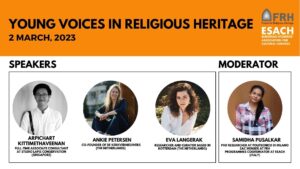
Young voices in heritage is a bimonthly column in our newsletter in collaboration with ESACH (European Students’ Association for Cultural Heritage) featuring young people’s perspectives on cultural heritage.
Since the last decade, community involvement in heritage has been one of the most discussed topics in academia as well as heritage practice. But questions on youth involvement in heritage have only risen in Europe in light of the COVID-19 Pandemic and due to the recent European Year of Youth. This provided a window of opportunity to shed light on youth involvement, or their lack of involvement in religious heritage. Understanding the importance of the youth’s role in protecting religious heritage, FRH started an initiative in 2022 -‘Young voices in heritage’, a bimonthly column in the newsletter in collaboration with ESACH (European Students’ Association for Cultural Heritage) featuring young people’s perspectives on cultural heritage.
After seeing an overwhelming response to the column, to further the discussion on this topic, on March 2nd, 2023, FRH Talks and ESACH Talks teamed up to host a webinar titled ‘Young voices in Religious heritage’ in which three young heritage professionals talked about the sustainability of religious heritage in Europe and the future of youth contributions to this specific sector.
Overview of the discussion & takeaways
The event started with Arpichart’s presentation where he discussed his work on the transboundary aspect of religious heritage, both in European and Asian contexts.
Transboundary in religious heritage research refers to the study and preservation of religious sites and even artefacts that cross national or cultural boundaries. This type of research is particularly important because religious heritage is often deeply rooted in a specific cultural context. But allowing it to stem away from singular views onto a much broader perspective could help the protection of religious heritage to be more sustainable by including best practices from around the world to act as inspiration. It could involve scholars such as Arpichart, religious communities and organisations from different countries and cultures to develop strategies for preserving and managing religious heritage sites.
One example Arpichart gave in his presentation was on the research he conducted as a comparative analysis of the work he had undertaken in relation to religious heritage sites while completing his studies at KU Leuven in Belgium and later about his work examining churches located in Bangkok and Singapore. This comparative analysis further contributes to the concept of transboundary that Arpichart emphasised in his presentation, highlighting the benefits of the cross-cultural outlook of understanding, analysing and preserving tangible and intangible aspects of religious heritage, such as architectural styles and sense of belongingness, respectively.

Later, Ankie spoke about the active community involvement that her organisation De Kerkvernieuwers utilises while dealing with religious heritage sites in the Netherlands. It is evident from her current work to see that religious sites serve as centres of social, religious, and cultural activity where community involvement is crucial for sites’ continued preservation and success.
One way in which communities can get involved in activities at religious heritage sites is by participating in events and celebrations. Many religious sites host festivals, ceremonies, and other gatherings that are open to the public. By attending these events or volunteering to support the site’s ongoing maintenance and preservation, community members can learn more about the site’s history and significance while building a sense of ownership and investment in the community.
Ankie shared many such instances where her organisation had successfully engaged the local community in participating in events which are in direct relation to religious heritage, accenting the importance of how initiatives can encourage community engagement by adapting their repertoire of work to the contemporary needs of the communities in which they reside.
Lastly, Eva presented her experience of curating exhibitions at Nieuwe Kerk Breda (Great Church of Breda, the Netherlands) with some very intriguing visuals that surely had an impact on many audience members present at the event. She spoke on how the transhistorical dimension of religious heritage has helped the church to host some of the most creative, engaging and thought-provoking exhibits over these years.
This transhistoric aspect of religious heritage, similar to transboundary, deals with a multi-faceted nature of religious heritage, that specifically emphasizes connections and continuities that exist between different periods and traditions. It not only seeks to unveil the common themes and patterns that have persisted across time and space but also highlights the importance of interfaith and cross-cultural dialogue. By exploring the ways in which multiple heritage values interacted and influenced each other over time, we can gain a deeper understanding of the diverse and complex nature of religious heritage, in order to protect and interpret it in a better and balanced way.
The examples of curatorial work shown by Eva introduced us to the multitude of options religious buildings can provide for contemporary exhibitions and concepts, creating a merge between the past and the present, and paving a new way for young people to engage with religious heritage, sparking their interests in the buildings and the contents within them.
All these three aspects that were discussed during the talk came across to be intertwined with a shared goal of looking at religious heritage in a futuristic manner. Moreover, especially being presented from a young professional’s perspective, the discussions encouraged the audience to take up a much fresher outlook towards looking at religious heritage and its sustainable future. The takeaways from the discussions asserted that there are indeed ways to invite and engage young people with religious heritage, whether it be on an individual or collective level.
By
Samidha Mahesh Pusalkar
PhD researcher at Politecnico di Milano
FRH SAC member
Programmes Coordinator at ESACH
&
Jana Zarkovic
MA of Cultural Studies
FRH Associate member
Talks Coordinator at ESACH





Follow us: